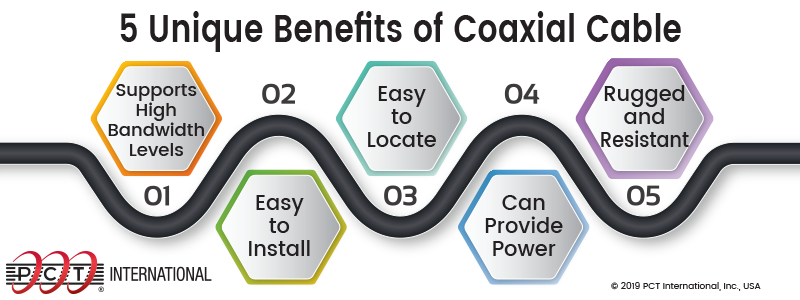5 Unique Benefits of Coaxial Cable
Author: Leonard Visser, PCT VP Engineering, 2/01/2019
Coaxial and fiber cable each have their place, with their own advantages and characteristics. Depending on the application, there may be no “right” or “wrong” answer when choosing their integration into the network. In fact, hybrid fiber / coax systems can combine the benefits of both.
As businesses become increasingly cost conscious, and costs of fiber optic cable and labor remain high, broadband professionals are starting to take a closer look at ways to squeeze more performance from coaxial cable. But before you decide whether coax or fiber is best for your application, there are a few benefits of coaxial cable that you should know about.

1. Coax Supports High Bandwidth Levels
When it comes to bandwidth, there seems to be no end to the increasing appetite of consumers. DOCSIS®3.1 provides support for up to 10 Gbps downstream and up to 1 Gbps upstream over coaxial cable. CableLabs® is conducting research to extend operating frequencies above the current 1 GHz to 1.8 or 3.0 GHz which will open the door to even higher bandwidth.
It is true that fiber theoretically has almost unlimited bandwidth, but tapping this bandwidth is much more difficult and often more expensive compared to coaxial cable implementations. Previously unknown obstacles, such as optical beat interference (OBI), could plague the rollout of fiber solutions. Coax is inherently OBI free!

2. Coax is Easy to Install
Let’s face it, coaxial cable is relatively easy to install and fiber can be a real pain. Coax can be installed using simple hand tools regardless of the cable size. There is only one conductor to deal with and it is large enough to easily see what you are doing. Fiber, on the other hand, often requires fusion splicing equipment, precise alignment, bulky splice enclosures, etc.
In the home, coaxial cable can be easily split and extended by the home owner. Currently, connected devices have RF (radio frequency) input / outputs, not optical, so higher cost media conversion is not needed. Damaged coaxial cable is easily repaired and weatherproofed without the need of fusion splicing and a splice enclosure.

3. Coax is Easy to Locate
It is often necessary to locate cable buried in the ground or behind walls. Because coaxial cable is metallic, it is easy to attach a tone generator to the shield and locate the cable. Fiber, on the other hand, is non-conductive and very difficult to locate. To avoid expensive digging and accidental damage, some fiber cables have an embedded wire to provide toning capability – but no other purpose. Coaxial cable does not require this baggage.

4. Coax Can Provide Power
Electronic devices require power to operate and coaxial cables can supply that power because they are metallic. Fiber cables, on the other hand, are non-conductive and cannot provide electrical power. Network powered modems for example can keep potentially lifesaving internet phone service working during local power outages or fire.

5. Coax is Rugged
Bad things happen and coaxial cables have superior resistance to cut through, crushing and bending. Hair thin fibers are easily broken so they must have lots of strength members, gels, yarns, armoring, and sheathing around them to resist becoming broken or micro-bent.
Would the benefits of coax satisfy the requirements of your next project? Visit pctinternational.com to learn more.


 Like faucets leaking if one faucet was leaking in every home the capacity for water would be limited. The same goes for F Connectors in the home and the data capacity we strive to increase to meet the capacity demand.
Like faucets leaking if one faucet was leaking in every home the capacity for water would be limited. The same goes for F Connectors in the home and the data capacity we strive to increase to meet the capacity demand.